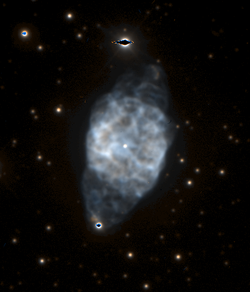
Summary
NGC 6905, also known as the Blue Flash Nebula, is a planetary nebula in the constellation Delphinus. It was discovered by William Herschel in 1784. The central star is 14.0 mag. The distance of the nebula, as with most planetary nebulae, is not well determined and estimates range between 1.7 and 2.6 kpc.[2]
| Emission nebula | |
|---|---|
| Planetary nebula | |
 Image based on observations made with ESO Telescopes at the La Silla Paranal Observatory | |
| Observation data: J2000 epoch | |
| Right ascension | 20h 22m 23s[1] |
| Declination | +20° 06′ 16″ [1] |
| Distance | 7.5 Kly (2.3 Kpc)[2] ly |
| Apparent magnitude (V) | 10.9[3] |
| Apparent dimensions (V) | 1.2′ |
| Constellation | Delphinus |
| Designations | Blue Flash Nebula[4] |
The shape of NGC 6905 is characterised by an internal shell with angular dimensions 47" ×34" and roughly conical extensions, with ansae-type formations along the major axis. The nucleus of the nebula possesses one of the most broad emission of OVI emission lines among planetary nebulae.[5] Moreover, OVIII emission has been detected in NGC 6905.[6] The ansae were particularly intense in NII.[5] The total mass of gas in NGC 6905 falls between 0.31 M☉ and 0.47 M☉.[7]
The central star has a spectral type of [WO2], meaning it has a spectrum similar to those of Wolf–Rayet stars and is rich in oxygen;[7] it is estimated to have a surface temperature of 150,000 K.[2][8] The spectrum also shows signs of neon emission lines.[7] Currently about 60% the mass of the Sun, before becoming a planetary nebula it had a mass of about 1.07 M☉.[7] An analysis of Gaia data suggests that the central star may be a binary system.[9]
NGC 6905 can be detected under dark skies with a 4-inch telescope, but it is better observed with larger instruments.[4]
References edit
- ^ a b "NGC 6905". SIMBAD. Centre de données astronomiques de Strasbourg. Retrieved 25 January 2016.
- ^ a b c Keller, Graziela R.; Herald, James E.; Bianchi, Luciana; Maciel, Walter J.; Bohlin, Ralph C. (1 December 2011). "A new grid of synthetic spectra for the analysis of [WC]-type central stars of planetary nebulae". Monthly Notices of the Royal Astronomical Society. 418 (2): 705–728. arXiv:1211.0223. Bibcode:2011MNRAS.418..705K. doi:10.1111/j.1365-2966.2011.19085.x. S2CID 85503661.
- ^ "Revised NGC Data for NGC 6905". spider.seds.org.
- ^ a b "The Blue Flash (NGC 6905)". observing.skyhound.com. Retrieved 25 January 2016.
- ^ a b Cuesta, L.; Phillips, J. P.; Mampaso, A. (1993). "Spectroscopy and shock modelling of the unusual bipolar outflow NGC 6905". Astronomy and Astrophysics. 266 (1): 199–212. Bibcode:1993A&A...267..199C.
- ^ Feibelman, Walter A. (1 January 1996). "The IUE Spectrum of the Planetary Nebula NGC 6905". The Astrophysical Journal. 472 (1): 294–307. Bibcode:1996ApJ...472..294F. doi:10.1086/178064. ISSN 0004-637X.
- ^ a b c d Gómez-González, V M A.; Rubio, G.; Toalá, J. A.; Guerrero, M. A.; Sabin, L.; Todt, H.; Gómez-Llanos, V.; Ramos-Larios, G.; Mayya, Y. D. (2022). "Planetary nebulae with Wolf–Rayet-type central stars – III. A detailed view of NGC 6905 and its central star". Monthly Notices of the Royal Astronomical Society. 509: 974–989. arXiv:2110.09551. doi:10.1093/mnras/stab3042.
- ^ Keller, G. R.; Bianchi, L.; Maciel, W. J. (11 June 2014). "UV spectral analysis of very hot H-deficient [WCE]-type central stars of planetary nebulae: NGC 2867, NGC 5189, NGC 6905, Pb 6 and Sand 3". Monthly Notices of the Royal Astronomical Society. 442 (2): 1379–1395. arXiv:1405.6763. Bibcode:2014MNRAS.442.1379K. doi:10.1093/mnras/stu878.
- ^ Chornay, N.; Walton, N. A.; Jones, D.; Boffin, H. M. J.; Rejkuba, M.; Wesson, R. (2021). "Towards a more complete sample of binary central stars of planetary nebulae with Gaia". Astronomy & Astrophysics. 648: A95. arXiv:2101.01800. Bibcode:2021A&A...648A..95C. doi:10.1051/0004-6361/202140288. S2CID 230770301.
External links edit
- Media related to NGC 6905 at Wikimedia Commons


